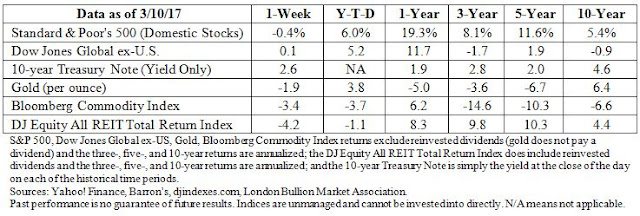Follow us
March 13, 2017
Rate Hike Ahead... Maybe
Last week's U.S. employment report was better than expected. The United States added 235,000 jobs in February, which was a few more than economists had forecast.
It may seem counter intuitive, but the positive economic data helped push U.S. stock markets lower. The jobs report was a sign the American economy continues to be strong and indicates a rate hike may be on the horizon. Barron's reported:
"If anything, the data just confirms what we've known for a while now: The economy is growing, and one rate hike is unlikely to do much damage...There's still a strong likelihood of some sort of economic stimulus plan from the Trump administration sometime this year...But the fact that tax cuts and infrastructure projects are even being considered at a time when the U.S. economy is adding 200,000-plus jobs a month is 'unprecedented'..."
Federal Reserve (Fed) interest rate hikes affect stock markets because they make borrowing more expensive. Higher borrowing costs may reduce the amounts people and companies spend and affect companies' profitability and share values.
At the end of last week, CME's FedWatch Tool, which gauges the likelihood of changes in U.S. monetary policy, indicated there was better than an 88 percent chance of a rate hike when the Fed meets on March 15.
It's interesting to note investor sentiment has become less optimistic. Last week, the AAII Investor Sentiment Survey showed investor pessimism had reached its highest level since February 2016. Bearish sentiment increased by almost 11 points, finishing at 46.5 percent. That's significantly higher than the historic average of 30.5 percent. Bullish sentiment fell by almost eight points to 30 percent. That's below the historic average of 38.5 percent. The AAII survey is often used as a contrarian indicator.
They're All On The Pro Rodeo Circuit
They all grow corn and soybeans. They all have renowned universities. In addition, according to The Economist, Texas, Iowa, Nebraska, Mississippi, Alabama, and Michigan are likely to experience the biggest increase in tariffs - as a percent of state gross domestic product (GDP) - if and when the North American Free-Trade Agreement (NAFTA) is revised.
Under NAFTA, goods are imported from and exported to Mexico and Canada without tariffs, which are essentially taxes on imported goods. Tariffs typically increase the cost of imports, making them less attractive to consumers. This can help support the market for domestically produced goods and help protect domestic jobs and industries. Currently, the United States sends about $240 billion worth of goods to Mexico, each year, and Mexico sends even more to the United States.
The Economist's analysis measured potential increases in tariffs, in tandem with the volume of state exports to Mexico, to determine the possible impact on a state's economy. (The analysis did not include Canadian exports, even though Canada is also a NAFTA participant.) While the effect on the majority of states' economies would be relatively small, the impact on others could be more significant:
"In 2015, Iowa's farmers shipped $132M of high-fructose corn syrup to Mexico. Without NAFTA, Mexico would slap a tooth-aching 100 percent tariff on the stuff...Among this group, Texas stands out. It faces an average tariff of only 3 percent, but its exports to Mexico are worth nearly 6 percent of its GDP (compared with 1.3 percent nationally)...Michigan also fits this category. Its exports of cars and parts - many of which end up back in America - would attract tariffs averaging only about 5 percent. But, with such shipments totaling $4.1B, the bill would be painfully large."
No one yet knows how renegotiating NAFTA may affect any of the countries involved because talks are not expected to begin for several months.
Weekly Focus - Think About It
"Making good decisions involves hard work. Important decisions are made in the face of great uncertainty, and often under time pressure. The world is a complex place: People and organizations respond to any decision, working together or against one another, in ways that defy comprehension. There are too many factors to consider. There is rarely an abundance of relevant, trusted data that bears directly on the matter at hand. Quite the contrary - there are plenty of partially relevant facts from disparate sources - some of which can be trusted, some not - pointing in different directions. With this backdrop, it is easy to see how one can fall into the trap of making the decision first and then finding the data to back it up later. It is so much faster. But faster is not the same as well-thought-out."
--Thomas C. Redman, "the Data Doc"




No comments:
Post a Comment
Note: Only a member of this blog may post a comment.